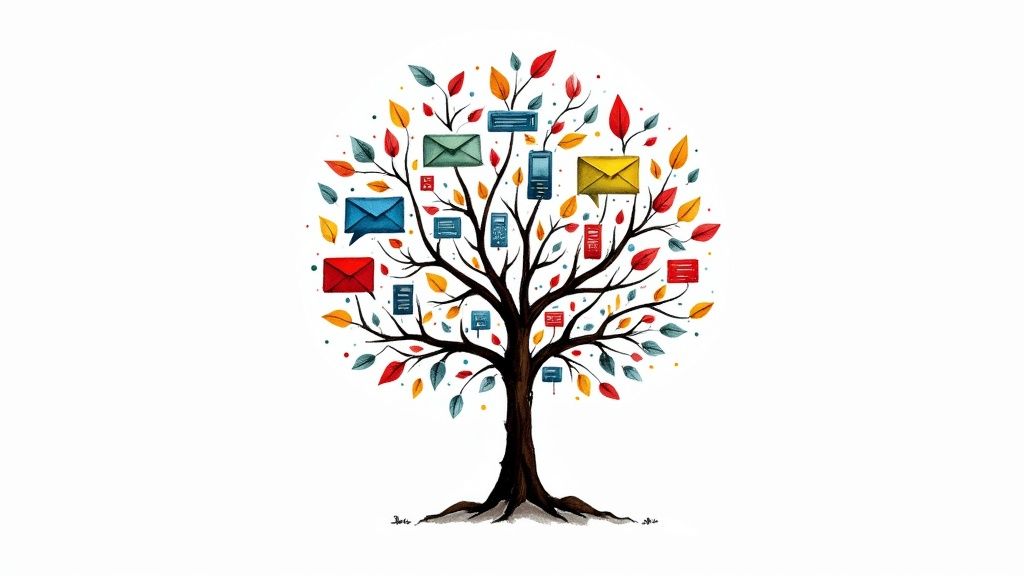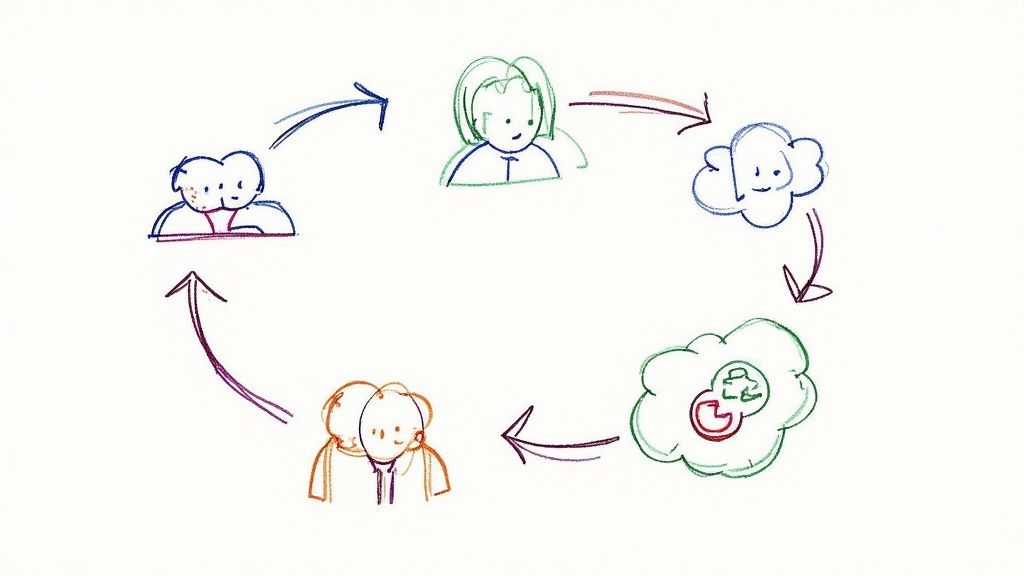15 Customer Retention Strategies That Boost Growth
Understanding the Real Economics of Customer Retention

Smart businesses know that keeping existing customers happy is far more cost-effective than chasing new ones. The numbers tell a clear story - studies show that finding new customers can cost anywhere from 5 to 25 times more than retaining current ones. Put simply, you might need to spend $25 on acquisition for every$ 1 you invest in keeping your existing customers satisfied.
Why Retention Matters More Than You Think
The cost difference is just the beginning of why customer retention deserves attention. When it comes to making sales, existing customers convert at an impressive 60-70% rate, while new prospects only convert at 5-20%. This huge gap makes sense - your current customers already know and trust your brand. They understand what you offer and are more likely to give you the benefit of the doubt if small issues arise. Even better, satisfied customers often become vocal advocates, naturally spreading the word about your business to others.
The Long-Term Value of Loyal Customers
The benefits of customer loyalty compound over time. Repeat customers are five times more likely to buy again and four times more likely to tell friends about your business. They're also seven times more inclined to try your new products or services. Your loyal customers essentially function as both a test audience and a marketing team. This creates a positive cycle - happy customers fuel organic growth, which helps you retain even more customers, leading to further expansion.
Beyond Basic Metrics: Building a Retention-Focused Culture
Real customer retention goes deeper than just tracking numbers. It requires fundamentally changing how your business builds relationships with customers. This means creating genuine connections at every interaction, offering personal attention, solving problems before they arise, and staying in touch through multiple channels. Consider this sobering fact - U.S. companies lose $136.8 billion each year because customers leave for preventable reasons. To avoid this fate, businesses must stop simply reacting to problems and start actively nurturing customer relationships. When you truly understand the economics of retention and make it central to your operations, you create the foundation for lasting success built on a loyal customer base.
Mastering the Art of Customer Experience Personalization
A strong customer base that keeps coming back is essential for any growing business. While basic personalization like adding customer names to emails is common, truly effective personalization goes much deeper - it's about understanding and responding to each customer's unique preferences and behaviors. When done well, this creates authentic connections that keep customers engaged and loyal over the long term.
Understanding the Power of Personalized Experiences
Think about your local coffee shop, where the barista knows your name and starts preparing your usual order as soon as you walk in. That simple personal touch makes you feel valued and connected. The same principle applies to online interactions - customers want to feel known and understood. Recent studies show that 80% of people prefer doing business with companies that personalize their experience. This could mean recommending products based on their past purchases or sending targeted offers that match their interests, rather than generic marketing messages.
Implementing Personalization Across the Customer Journey
Good personalization isn't just a one-time thing - it needs to happen consistently at every customer touchpoint. From someone's first visit to your website through their repeat purchases, each interaction is a chance to show you understand their needs. This includes customizing welcome emails for different customer segments, creating special product bundles based on buying patterns, and providing support that takes into account their history with your business. When customers feel understood at every step, they're more likely to stick around.
Leveraging Customer Data While Maintaining Trust
The key to effective personalization is smart use of customer data from various sources - website behavior, purchase history, and support interactions. However, it's vital to be open and honest about how you collect and use this information. Being clear about your data practices and giving customers control over their privacy preferences builds trust. For example, having an easy-to-understand privacy policy and letting customers choose their communication preferences shows you respect their rights while still delivering personalized experiences.
Practical Tactics for Driving Measurable Improvements
Several proven approaches can boost customer loyalty through personalization. Personalized email campaigns, for instance, can increase retention by up to 33%. Product recommendations based on individual shopping patterns can improve retention by 30%. Grouping customers with similar traits for targeted messaging can boost retention by 37%. These aren't just abstract concepts - they're practical tools that consistently deliver results. By putting these strategies into action and measuring their impact, businesses can build stronger customer relationships that drive sustainable growth.
Building a Proactive Support System That Actually Works

While personalization helps build customer relationships, the real key to keeping customers is having support that solves problems before they happen. This means shifting from just responding to issues to actively preventing them. When done right, proactive support leads to happier customers who stick around longer and feel more connected to your brand. Making this work requires fundamentally changing how your team approaches customer service.
Anticipating Needs and Preventing Problems
The foundation of proactive support is really understanding your customers. By looking at data from past purchases, support conversations, and how people use your website, you can spot potential issues early. For example, if you notice several customers getting stuck on the same feature, you could send them helpful tips or a quick video tutorial before they need to contact support. Think of it like a doctor focusing on prevention rather than just treating symptoms - identifying and addressing small issues before they become major problems.
The Power of Predictive Support Systems
Modern tools like artificial intelligence help make predictive support possible. These systems analyze customer behavior patterns to catch potential problems and suggest solutions. For instance, if someone seems to be struggling during checkout, an AI chatbot could jump in with helpful guidance before they give up and abandon their cart. This kind of real-time help prevents frustration and keeps more customers moving smoothly through their purchase journey.
Closing the Loop With Effective Feedback
Good proactive support needs continuous input from customers to stay effective. Regular surveys, in-app questions, and social media monitoring help you understand what's working and what isn't. But collecting feedback is just the start - you need to act on it too. When customers see you making changes based on their input, it shows you truly value their opinions. One software company put this into practice by redesigning a confusing feature after getting customer feedback. The result? Higher satisfaction scores and fewer support tickets about that specific issue.
Scaling Proactive Support Without Losing the Personal Touch
As your customer base grows, keeping support personal becomes more challenging. The solution lies in finding the right balance between automation and human connection. Using tools for customer segmentation, targeted email campaigns, and personalized in-app messaging lets you deliver individualized support at scale. Think of it as building a smart system where technology and human touch work together - like a well-coordinated team where each member plays their part in keeping customers happy and loyal.
Crafting Multi-Channel Engagement That Drives Loyalty
The foundation of solid customer retention lies in connecting with customers where they already are. Gone are the days of relying on a single communication channel. Today's successful brands build lasting relationships by maintaining consistent, valuable interactions across multiple platforms - from email to social media to mobile apps.
Orchestrating a Seamless Brand Experience Across Channels
Creating effective multi-channel engagement requires more than simply copying and pasting the same message everywhere. Each platform serves a unique purpose and demands its own approach. For example, email works best for sharing detailed product updates and exclusive offers, while social media shines at building community through conversations and shared experiences. The numbers back this up - 89% of marketers rely on email for customer retention, while 83% leverage social media platforms like Facebook and Instagram. Mobile messaging has also become essential, with 58% of marketers now focusing on SMS and app-based communications.
Delivering the Right Content at the Right Time
Like instruments in an orchestra, each channel plays its own vital part in creating a complete customer experience. Email campaigns can suggest products based on previous purchases to encourage repeat business. Social media allows for real-time interaction through polls, contests and discussions that strengthen brand connections. In-app messages provide help exactly when customers need it. You might also explore newer formats like personalized video messages or interactive content to keep engagement fresh and meaningful.
Measuring and Optimizing Cross-Channel Performance
Success requires constant monitoring and refinement of your multi-channel strategy. Pay attention to key metrics like email engagement rates, social media interactions, and conversion data from each platform. This information reveals what content resonates with your audience and which channels drive the best results. For instance, if email open rates drop, try testing different subject lines or segmenting your list differently. When social posts get less engagement, experiment with new content types or posting times. Through ongoing measurement and optimization, you can build an engagement strategy that consistently strengthens customer loyalty over time. The key is viewing all channels as interconnected parts of a single system focused on building stronger customer relationships.
Designing Loyalty Programs That Actually Matter

Let's move beyond basic points and discounts to explore what makes loyalty programs truly effective in keeping customers coming back. Modern consumers want more than just transactional benefits - they seek genuine value, special access, and a real connection with brands they support. Here's how to create a program that delivers meaningful results.
Understanding the Psychology of Loyalty
What makes customers stick with certain brands? The answer lies in how valued and appreciated they feel. When companies offer personalized perks that show they understand their customers' needs, it creates a lasting bond. For instance, giving early access to new products or suggesting items based on past purchases makes the experience feel special and personal. This speaks to the 80% of customers who say they prefer companies that tailor experiences to their preferences.
Structuring Rewards That Drive Engagement
The way you organize rewards can make or break your program's success. Rather than a simple points system, consider creating different membership levels with better perks at each tier. This gives customers clear goals to work toward while making higher-level members feel like VIPs. Mix in unique experiences too - whether it's members-only events or special services. These create memorable moments that build real emotional connections between customers and your brand.
Examples of Effective Loyalty Programs
Several companies show how this works in practice. Take Sephora's Beauty Insider program - it offers exclusive events, personalized product suggestions, and first access to sales, hitting all the right notes for beauty enthusiasts who value being "in the know." Amazon Prime takes a different approach, bundling practical benefits like fast shipping with entertainment perks and special deals to create an all-in-one membership that keeps customers engaged across multiple services.
Using Data for Continuous Improvement
Success requires staying on top of how your program performs. Watch key metrics like how often members engage, which rewards they use most, and what drives the most value. Look at patterns in purchase frequency, average spending, and customer lifetime value to spot opportunities for improvement. By regularly fine-tuning based on real customer behavior and feedback, you can keep your program fresh and relevant. This ongoing process helps ensure your loyalty program delivers genuine value that keeps customers coming back year after year.
Measuring What Matters in Customer Retention

Smart customer retention strategies require measuring and tracking the metrics that truly matter. While it's tempting to focus on surface-level numbers, the real insights come from key performance indicators (KPIs) that directly connect to your business goals and revenue. Let's explore the essential metrics that help you understand how well you're keeping customers and where you can improve.
Key Metrics for Customer Retention Success
Here are the core metrics that help businesses track and improve their customer retention efforts:
- Customer Retention Rate: This basic but vital number shows what percentage of customers stay with you over time. For example, if you keep 75 out of 100 customers over three months, that's a 75% retention rate. This metric gives you a clear view of your overall ability to maintain customer relationships.
- Customer Churn Rate: This is the percentage of customers who leave, which complements your retention rate. If you see a 25% churn rate, it means you're losing one in four customers - a clear signal to investigate why they're leaving and how to keep them engaged.
- Customer Lifetime Value (CLTV): This shows how much revenue you can expect from each customer throughout your relationship. It helps you see the long-term value of keeping customers happy and coming back. For instance, a customer who makes small but regular purchases might be worth more than one who makes a single large buy.
- Repeat Purchase Rate: This tells you what percentage of customers buy from you more than once. When this number goes up, it shows your customers like what you offer enough to return. Plus, repeat customers often spend more over time.
- Purchase Frequency: This reveals how often customers buy from you, helping you time your marketing and outreach effectively. If most customers buy quarterly, you can plan promotions and communications around their natural buying cycle.
Building a Data-Driven Retention Strategy
These metrics do more than fill spreadsheets - they tell the story of your customer relationships. By watching these numbers closely, you can spot problems early and make smart improvements. A drop in repeat purchases might show you need better follow-up emails or loyalty rewards. High churn could mean it's time to improve your customer service or product quality.
From Measurement to Action: Optimizing Your Retention Efforts
The real power of tracking these metrics comes from using them to make your retention efforts better. Think of it like tending a garden - you need to regularly check on things and make small adjustments to help everything grow. This means looking at your numbers regularly, spotting patterns, and testing new approaches based on what you learn.
When you understand what the data tells you, you can create more focused and personal ways to keep customers. For example, if you notice certain types of customers tend to stick around longer and spend more, you can give them special attention through custom offers or priority support.
Ready to empower your business with a custom AI chatbot tailored to your unique content and brand identity? Sitebot makes it easy to create multilingual chatbots that deliver precise and relevant customer interactions without coding. Integrate seamlessly on your website or platforms like Slack and Zendesk. Gain valuable insights with advanced analytics to optimize customer engagement and drive business growth. Build stronger customer relationships and boost retention with personalized support, optimized lead generation, and instant assistance. Start building your chatbot today with Sitebot's intuitive three-step process! Visit Sitebot now!


